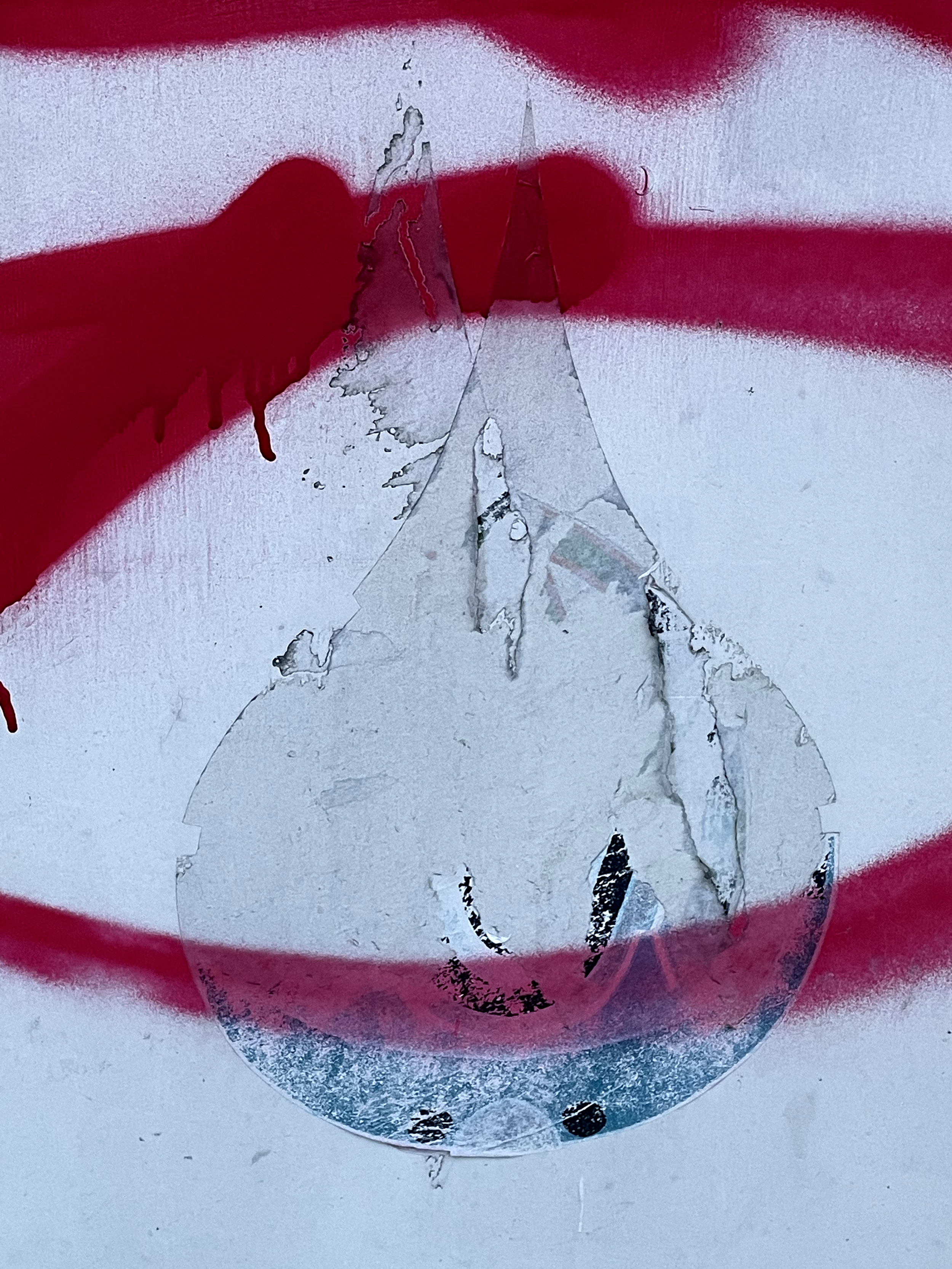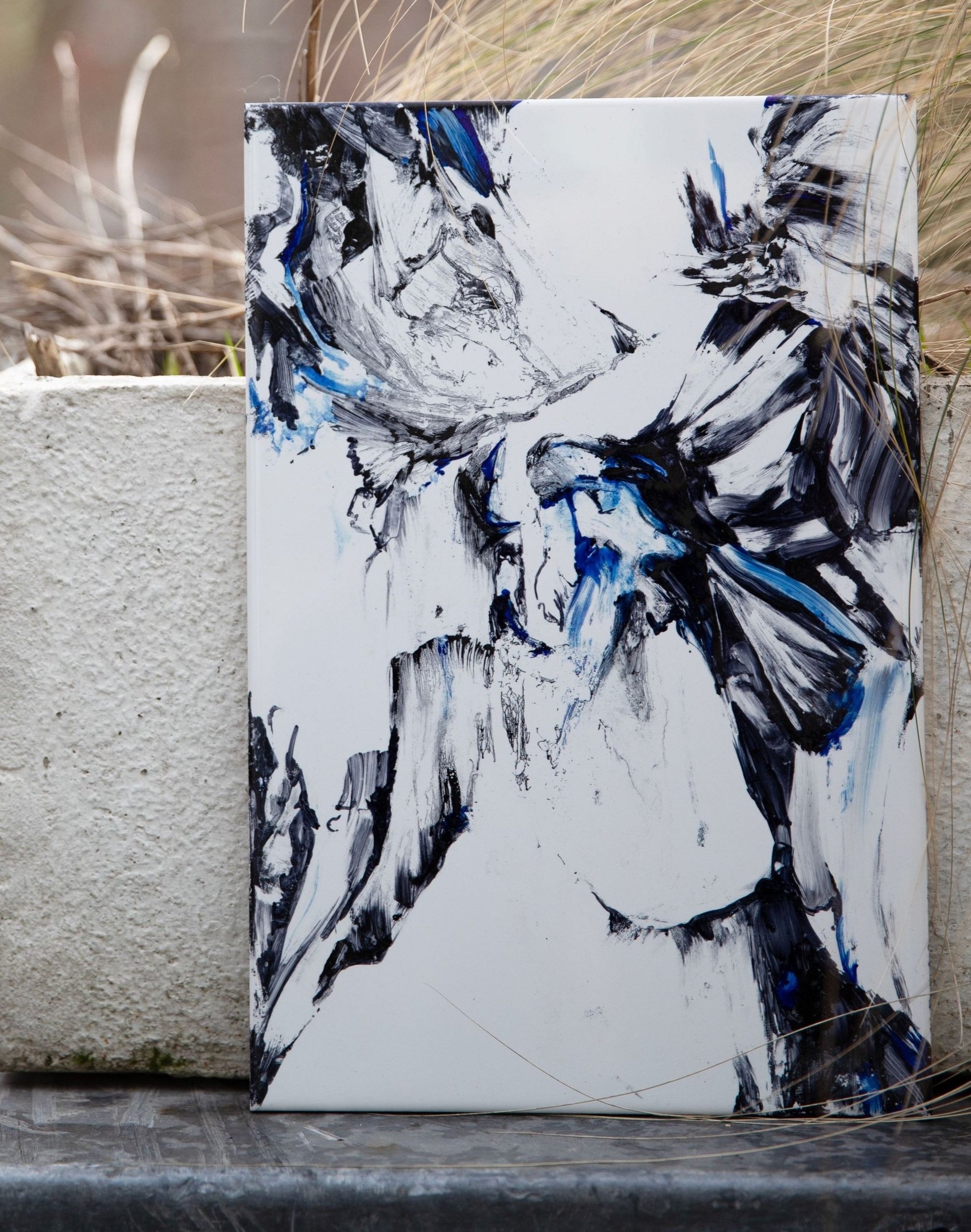What remains once a building has fulfilled its purpose? How are its layers of memory and past existence made visible or erased?
Day 1 in the studio, unpacking/playing around with found objects, December 2021.
Marker on whiteboard, reflective and thermal tape, 2021
Detail of permanent marker and window cleaner on ceramic bathroom tile, 2022, 60 x 30 cm
Studies for Residue, permanent marker and window cleaner on ceramic bathroom tile, resin, 2022, various sizes
Residue, permanent marker and window cleaner on ceramic tile, 20 x 10 cm each
Residue installation shot, permanent marker and window cleaner on ceramic tile, builder’s line, acrylic plywood, 2022, 96.5 x 71 x 42.5 cm
Residue window display, permanent marker and window cleaner on ceramic tile, builder’s line, plywood, 2022, 97 x 71 x 43 cm each
Positioned in this state of liminality, degradation and material existentialism, one building prompts such questions. The area surrounding Rodic Davidson Architects serves as the point of departure for Residue, where we focused on the fate of the building once known as The Cochrane Theatre: a building anticipating demolition and redevelopment.
Residue install shot, Rodic Davidson Architects window front
Unique for its locality, the building holds a Certificate of Immunity (COI) that prevents it from becoming nationally protected as a ‘listed’ building - significant alteration to its fabric and structure is permitted, and arguably, encouraged. Its current construction is therefore condemned to a residual existence.
Installation of ceramic bathroom tile fragments from Residue in the studio
By using a material rendered obsolete — excess bathroom tiles from warehouse suppliers and discarded fragments from DIY projects — and marking these with impressions of The Cochrane’s demise, we draw into question the idea of legacy - as residue.
Residue
Trace
Remnant
Substrate
Vestige
Particulate
Fragment
Echo
Shadow
Ghost
Memory
Residue Trace Remnant Substrate Vestige Particulate Fragment Echo Shadow Ghost Memory
Through a process of rapid drawing in permanent marker and subsequent application of surface cleaner, carefully crafted markings on the tiles were left to erode in a process reminiscent of their former function. The erasure that household tiles undergo during a lifetime of constant cleaning is suspended through the partial presence of the ‘permanent’ marks drawn across the tiles’ surface in the architects’ window. By entangling these pieces in a web of high-visibility builders line, a material traditionally used when bricklaying to delineate areas yet-to-be built, we explore the interplay between ideas of renewal, construction and destruction. Equipping residue as simultaneously our material, concept and creative output, we add to both the building and the art pieces’ eternal chains of residual existence.

The Cochrane Theatre
History of the Building
The Jeanetta Cochrane Theatre was first opened in 1963, and has since been used as a performance space, initially by Central Saint Martins as a base for their costume and set design school. It was home to the Talawa theatre company in the nineties, and subsequently host to a number of Television shows including Channel 4’s TFI Friday, ITV’s The Nightly Show, and Channel 5’s Do The Right Thing, before closing in 2012, when the building was sold to hotel developers.
Since its sale, it has held a renewed Certificate of Immunity, and has been described by the local Council as ‘ha{ving} a number of meanwhile uses:’ such as the setting to performance artist Sophia Al-Maria’s 2019-20 film Beast Type Song, which explores themes of erasure, identity revision and the intersection of past and present against the backdrop of the derelict former campus.
Certificate of Immunity (COI):
As defined by Historic England, a COI stands for ‘Certificate of Immunity’ a legal status mechanism preventing a building from being considered for heritage listing for the next five years. Since 2015, a building deemed to be eligible for listing, as a site of historic and architectural interest, yet preferred by its owners for demolition and redevelopment, may be put forward for a Certificate of Immunity to anticipate the process of planning its replacement. Without it, under the Acts of 1913, any alteration to a listed building could be deemed as damage and incur a fine. The COI is thus a protection from permanency, a provisional hoop in the architectural deadline.




Residue 28, permanent marker and window cleaner on tile, 2022, 20 x 30 cm
Image: Chater Paul Jordan
The eternal life of iron and glass,
cement aware of its own mortality,
by what means are the relics of unwritten histories transformed to rubble?
Before a fracture comes a fissure and before the fissure was only the blank slate.
Lucia Neirotti for Residue
{…} If time leaves none unscathed, then what was ever really here?
And then another takes ones place,
And recycled glass shines too,
Crafted from recycled flesh,
Was I lost in its making?
Like the phoenix rose from ashes,
I became my legacy {…}
Jacob Johnson for Residue
About the Artists
We invented RESIDUE out of a collective desire to explore transient spaces. Visiting each other's respective workplaces in early January, a studio under construction and the RDA’s display front, our shared environments of fine art, art history and architecture unfolded laterally into this window of opportunity. To fill a box in the two-week period we were given became an experiment in expansion, made most apparent in how we worked together. One fuelled the other’s ideas into movement, in such a way that it became difficult to delineate a boundary between our relationship as ‘artists’ and ‘curators.’ Perhaps exemplifying this best is the way in which we used blue string to both reflect and feed back into monochrome and blue permanent marks throughout the exhibition, such that the two emerged as an interdependent mass of lines.
This is how we began, and it is how we intend to proceed: although this exhibition marks our first as an artistic duo, where we go next is another boundary we wish to dissect.
Sophia is a multimedia artist and curator working in large-scale installations, spatial construction and painted murals. She is practice manager at Rodic Davidson Architects’ (RDA) London office.
Apolline and Sophia installing the tiles in Pied Bull Yard.

















